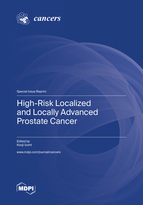High-Risk Localized and Locally Advanced Prostate Cancer
A special issue of Cancers (ISSN 2072-6694).
Deadline for manuscript submissions: closed (31 December 2022) | Viewed by 32840
Special Issue Editor
Interests: prostate cancer; androgen receptor; castration-resistant prostate cancer; immuno-oncology
Special Issues, Collections and Topics in MDPI journals
Special Issue Information
Dear Colleagues,
The recent imaging modality has been able to find small metastasis in patients who are diagnosed as having high-risk localized and locally advanced prostate cancer by conventional modalities. However, the impact of the development of imaging modality on prognosis is not fully assessed because of the paucity of the data. Hence, the definition of high-risk localized and locally advanced prostate cancer may change according to the development of imaging modality, and it is a particularly important category of prostate cancer. Although there are some reasonable treatment choices for high-risk localized and locally advanced prostate cancer, no standard of care is established so far. Radical prostatectomy, brachytherapy, and sometimes hormonal therapy are applied for such patients, and there are different risks and benefits involved in each treatment. This Special Issue calls for clinical studies and reviews of diagnosis and treatment in “High-Risk Localized and Locally Advanced Prostate Cancer”. The biology and mechanisms in local invasion of prostate cancer are also welcome.
Prof. Kouji Izumi
Guest Editor
Manuscript Submission Information
Manuscripts should be submitted online at www.mdpi.com by registering and logging in to this website. Once you are registered, click here to go to the submission form. Manuscripts can be submitted until the deadline. All submissions that pass pre-check are peer-reviewed. Accepted papers will be published continuously in the journal (as soon as accepted) and will be listed together on the special issue website. Research articles, review articles as well as short communications are invited. For planned papers, a title and short abstract (about 100 words) can be sent to the Editorial Office for announcement on this website.
Submitted manuscripts should not have been published previously, nor be under consideration for publication elsewhere (except conference proceedings papers). All manuscripts are thoroughly refereed through a single-blind peer-review process. A guide for authors and other relevant information for submission of manuscripts is available on the Instructions for Authors page. Cancers is an international peer-reviewed open access semimonthly journal published by MDPI.
Please visit the Instructions for Authors page before submitting a manuscript. The Article Processing Charge (APC) for publication in this open access journal is 2900 CHF (Swiss Francs). Submitted papers should be well formatted and use good English. Authors may use MDPI's English editing service prior to publication or during author revisions.
Keywords
- imaging modality
- oligometastasis
- radical prostatectomy
- lymph node dissection
- brachytherapy
- hormonal therapy
- neoadjuvant/adjuvant therapy
- quality of life
- local invasion







